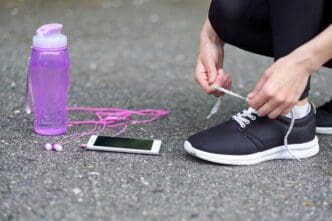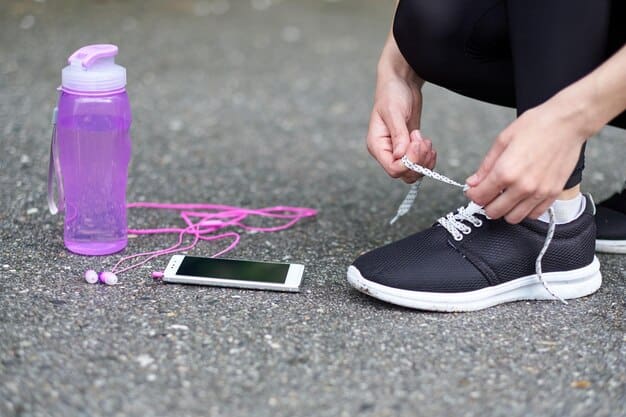Choosing your first pair of running shoes is a foundational step in building a healthy and sustainable running practice. For any new runner, the right shoe can mean the difference between enjoying miles of injury-free progress and quitting due to discomfort or pain. The most effective way to find the perfect pair is to visit a specialty running store for a professional fitting, where experts analyze your gait and foot mechanics. This process helps match you with a shoe that provides the correct level of support and cushioning for your unique needs, ensuring comfort and reducing the risk of common running-related injuries.
Why You Can’t Just Run in Any Old Sneaker
While that stylish pair of cross-trainers or fashion sneakers might look the part, they are not engineered for the specific demands of running. Running is a high-impact activity that involves a repetitive, forward-motion stride, and running shoes are built specifically to accommodate this.
Running shoes provide critical cushioning to absorb the shock that travels up your legs with every footstrike, protecting your joints from stress. They also incorporate support features designed to guide your foot through a healthy range of motion, preventing harmful twisting or rolling.
Unlike court shoes designed for lateral movement or walking shoes built for a low-impact gait, running shoes are lightweight and flexible in just the right places to promote an efficient, forward stride. Using the wrong type of footwear can lead to everything from blisters and shin splints to more severe stress injuries.
The Single Most Important Step: Visiting a Specialty Running Store
While online shopping offers convenience, nothing replaces the expertise and technology available at a dedicated running store for your first purchase. The staff are trained runners themselves who understand the nuances of shoe technology and biomechanics.
This is not a typical shoe-shopping experience. It is a personalized consultation focused entirely on your health and performance as a runner. Set aside at least 30 to 45 minutes for a thorough fitting.
What to Expect During a Fitting
The fitting process typically begins with a conversation. The sales associate will ask about your running goals, how many miles you plan to run per week, the surfaces you’ll run on (treadmill, road, trail), and any history of injuries.
Next comes the gait analysis. The associate will likely watch you walk or run barefoot to observe your natural foot motion. Many stores use a treadmill with a camera to record your stride from behind, allowing them to slow down the footage and precisely analyze your biomechanics, specifically a movement called pronation.
They will also measure both of your feet for length and width. Don’t be surprised if they recommend a shoe that is a half or even a full size larger than your casual shoes. Feet swell during exercise, and you need adequate room to prevent bruised toenails and blisters.
What to Bring With You
To get the most out of your fitting, come prepared. Bring the pair of socks you typically run in, as sock thickness can significantly affect shoe fit. If you use custom orthotics or specialized insoles, bring those as well, so you can test them inside the new shoes.
If you have an old pair of athletic shoes you’ve been using, bring them along. The wear patterns on the outsole can provide the expert with valuable clues about your gait and footstrike.
Deconstructing the Running Shoe: Key Terminology Explained
The world of running shoes is filled with technical jargon. Understanding the basic anatomy of a shoe will empower you to make a more informed decision and understand the associate’s recommendations.
The Upper
The upper is the soft, fabric part of the shoe that encases your foot. Modern uppers are typically made from engineered mesh or knit materials designed to be lightweight, breathable, and supportive. The goal is a secure but flexible fit that disappears on your foot, preventing hot spots and irritation.
The Midsole: The Engine of the Shoe
The midsole is the foam layer between the outsole (the rubber that hits the ground) and your foot. This is arguably the most important component, as it provides the shoe’s cushioning and stability. Midsoles are commonly made from EVA (ethylene vinyl acetate) foam or more advanced, responsive compounds like TPU (thermoplastic polyurethane).
Cushioning levels vary from minimal (a firm, connected-to-the-ground feel) to maximal (a plush, highly cushioned feel). As a new runner, a shoe with moderate cushioning is often a great starting point, offering a balance of comfort and responsiveness.
The Outsole
The outsole is the durable rubber on the bottom of the shoe that makes contact with the ground. Its primary functions are to provide traction and protect the midsole from abrasion. Road running shoes will have flatter, more durable rubber, while trail running shoes feature aggressive lugs for grip on uneven terrain.
Heel-to-Toe Drop
Heel-to-toe drop (or “offset”) is the height difference between the heel and the forefoot, measured in millimeters. A traditional running shoe has a drop of 8-12mm, while others have a lower drop (4-6mm) or even zero drop (0mm).
A higher drop can place less strain on the Achilles tendon and calf muscles, which can be beneficial for beginners or those with tight calves. Lower-drop shoes tend to promote more of a midfoot or forefoot strike. There is no “best” drop; it’s a matter of what feels most comfortable and natural for your body.
Stack Height
Often confused with drop, stack height is the total amount of shoe material between your foot and the ground. A shoe with a high stack height will generally have more cushioning (think maximalist shoes), while a low stack height provides a more grounded feel. A shoe can have a high stack height but still be zero-drop.
Understanding Your Foot and Stride
The gait analysis at the running store is designed to understand how your foot behaves when you run. The key factor they are observing is pronation.
Pronation Explained: Neutral, Overpronation, and Supination
Pronation is the natural inward roll of the foot as it transitions from heel to toe during a stride. This is a normal and necessary motion that helps your body absorb shock. Issues arise when this motion is excessive or insufficient.
Neutral Pronation: The foot rolls inward an appropriate amount (about 15%), effectively absorbing shock and aligning the leg for a powerful push-off. Most runners fall into this category.
Overpronation: The foot rolls inward excessively, beyond the 15% mark. This can cause instability and place extra stress on the ankle, shins, and knees.
Supination (or Underpronation): The foot fails to roll inward enough, causing the impact forces to be concentrated on the outer edge of the foot. This can lead to stress on the outer leg and IT band.
Shoe Categories: Neutral vs. Stability
Based on your level of pronation, you will be guided toward one of two main shoe categories.
Neutral Shoes: These shoes are designed for runners with neutral pronation or supination. They do not have corrective support features and allow the foot to move naturally, providing cushioning as their primary function.
Stability Shoes: These shoes are designed for runners who overpronate. They incorporate technology, such as firmer foam “guide rails” or “medial posts” on the inner side of the midsole, to gently guide the foot and prevent it from rolling too far inward.
What About Arch Type?
You may have heard about choosing shoes based on having flat, neutral, or high arches. While arch height can be a factor, modern shoe fitting focuses more on the dynamic motion of your foot (pronation) when running, rather than its static shape when standing. A gait analysis provides a much more accurate picture of what your foot needs.
Putting It All Together: The Final Selection Process
After the analysis, the associate will bring out several models from different brands that match your profile. Now it’s time to find the one that feels best.
The “Thumb’s Width” Rule
When trying on shoes, make sure there is about a thumb’s width of space between the end of your longest toe and the front of the shoe. Your feet need this room to splay and to accommodate for swelling. The width should be snug but not tight across the midfoot.
Comfort is King
Despite all the technology and analysis, the most important factor is subjective comfort. A shoe can have all the right technical features, but if it doesn’t feel good on your foot, it’s not the right shoe for you. The best shoe should feel like a natural extension of your foot.
Don’t Judge a Shoe by Its Color
It can be tempting to choose a shoe based on its aesthetic appeal, but this should be your last consideration. The fit and feel are far more important than the colorway. Luckily, most popular models come in a variety of colors, so you can often find one you like in the shoe that fits you best.
Caring for Your New Shoes and Knowing When to Replace Them
Your relationship with your running shoes doesn’t end when you leave the store. Proper care will ensure they perform well for their entire lifespan.
How Long Do Running Shoes Last?
The industry standard for replacing running shoes is every 300 to 500 miles (500 to 800 kilometers). The foam in the midsole compresses and breaks down with each step, and after a certain point, it loses its ability to absorb shock effectively, even if the shoe still looks fine on the outside.
Signs of Wear
Beyond mileage, listen to your body. If you start to develop new aches and pains in your feet, shins, or knees, it might be a sign that your shoes are worn out. Other visual cues include significant wear on the outsole tread and visible creasing or compression in the midsole foam.
Embarking on your running journey is an exciting endeavor, and selecting your first pair of shoes is a critical rite of passage. By investing the time to get a professional fitting and understanding the fundamentals of what makes a good running shoe, you are setting yourself up for success. The right pair will not only protect you from injury but will make every run more comfortable and enjoyable, paving the way for a long and healthy relationship with the sport.







